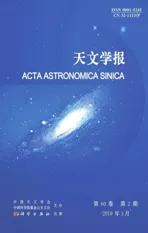银河系化学演化及球状星团多星族问题研究
2019-01-18王悦
王悦
(中国科学院国家天文台 北京 100101)
恒星的化学元素丰度特征能够反映其形成和演化历史.以化学元素丰度为手段,研究了银河系中恒星的径向迁移对银河系化学演化的影响,以及球状星团中渐进巨星支(AGB)恒星的多星族问题.
近年的观测和理论研究表明:恒星在银盘里有径向迁移.基于详细的银河系化学演化模型,再采用分布函数模拟恒星径向迁移过程,研究了恒星的径向迁移对银盘径向元素丰度梯度的影响.结果显示:太阳邻域的恒星诞生于很大的银心距范围内.恒星的径向移动使某一银心距处恒星的金属丰度弥散到一定范围,使恒星的年龄与金属丰度不再是单调关系.星际介质中铁元素和氧元素丰度沿银盘径向分布不会因为恒星的径向迁移而产生明显差异,即恒星的径向迁移不会明显改变元素丰度在银盘径向的梯度,但该梯度会因此变得平缓.年老恒星的元素丰度梯度比年轻恒星的更平缓.
球状星团是银河系的重要组成部分.光谱和测光的研究都揭示出球状星团中存在多个星族,利用欧洲南方天文台甚大望远镜(ESO/VLT)上的多目标中高分辨率光纤光谱仪FLAMES (Fibre Large Array Multi Element Spectrograph),对4个银河系球状星团(NGC 104、NGC 2808、NGC 6121、NGC 6809)的AGB和红巨星支(RGB)恒星样本进行了观测,从光谱数据得到了样本星的钠丰度.与RGB星相比,星团的AGB星的钠丰度也都呈现出显著的弥散,说明在这4个星团中均存在富钠的第2星族AGB星.K-S检验表明,NGC 104、NGC 2808和NGC 6809的AGB和RGB星的钠丰度可认为遵从同一分布,而NGC 6121的AGB和RGB星的钠丰度是不同的分布,明显缺乏高钠的AGB星.各星团样本中第1和第2星族恒星的数量及所占比例也可以得到.从文献中收集了另外4个银河系球状星团(NGC 5904、NGC 6205、NGC 6266、NGC 6752)的AGB和RGB星样本的钠丰度数据,对其中的NGC 6752的光谱数据进行了再分析.综合分析8个球状星团的AGB和RGB星样本的钠丰度分布情况以及第1和第2星族占比,我们发现AGB星呈现出比较复杂的情况:一些星团(NGC 6752和NGC 6266)中基本没有富钠的第2星族AGB星,一些星团(NGC 2808、NGC 5904和NGC 6809)的AGB星具有与RGB星相似的钠丰度弥散和第2星族占比,其他星团的情况则介于此两者之间.由此不能确定在第2星族AGB星的占比和所考虑的球状星团特征参数之间存在明确的依赖关系.
最后,对球状星团的星族划分方法进行了研究.首先检验了基于银河系场星钠丰度分布的区分球状星团第1和第2星族的钠丰度标准([Fe/H]的函数).通过比较由场星标准以及文献中分别单独考虑每个星团样本得到的17个球状星团样本的第1星族占比,发现场星标准会高估第1星族恒星所占的比例.考虑到球状星团的多样性,单独分析每个球状星团样本的星族划分方法更显合理.利用场星作为参考来划分球状星团的星族需要谨慎.对球状星团的星族和场星之间的联系还需要更深入的研究.
The chemical feature of stars is an indicator of its formation and evolution history.Taking advantage of the elemental abundances,we study the influence of the radial stellar migration in the Galactic disk on chemical evolution,and the multiple stellar populations of asymptotic giant branch (AGB)stars in globular clusters.
Stellar radial migration has been found in the disk of the Milky Way.We modeled the radial stellar migration in the Galactic disk with an analytical method,and added it to a detailed Galactic chemical evolution model to study the influence of the radial stellar migration on the chemical evolution of the Milky Way,especially on the abundance gradients.We find that stars currently located in the solar vicinity were born in a large range of Galactocentric radius.The radial stellar migration can scatter the stellar abundance at a given Galactocentric radius,leading to a large dispersion around the classic simple agemetallicity relation.After migration,the abundance gradients along the Galactic radius would not be changed significantly by the radial stellar migration.However,the migration can flatten the radial gradients of the mean chemical abundance of stars,and older stars possess flatter abundance gradients than younger stars.
Globular clusters are important components of the Milky Way.Large amount of spectroscopic and photometric studies have shown that there are multiple stellar populations in globular clusters,which has been accepted as a general feature of globular clusters.In this work,with the high-resolution spectra obtained with the multi-object high-resolution fibre spectrograph FLAMES(Fibre Large Array Multi Element Spectrograph)on the Very Large Telescope of European Southern Observatory (ESO/VLT),we derived accurate Na abundances for the AGB and RGB (Red Giant Branch)sample stars of four Galactic globular clusters,i.e.NGC 104,NGC 2808,NGC 6121,and NGC 6809.Through the Na abundance distributions of the four globular clusters,we find that,compared with the RGB stars,the Na abundance of the AGB stars also show significant dispersions indicating that there are Na-rich second-population AGB stars in all of the four clusters.A K-S test shows that the Na abundance of the AGB and RGB stars of NGC 104,NGC 2808,and NGC 6809 can be regarded following the same distribution,while it is not the case for NGC 6121,and this cluster lacks the most Na-rich AGB star.Moreover,according to the Na abundance,we also determined the numbers and fractions of first- and second-population stars in both AGB and RGB samples of the four clusters.
In addition,we gathered from literature the Na abundances of AGB and RGB samples of another four Galactic globular clusters,i.e.NGC 5904,NGC 6205,NGC 6266,and NGC 6752,among which we re-analyzed the spectral data of the sample of NGC 6752 with our own method.The Na abundance distribution of their AGB and RGB samples and the fractions of their first- and second-population stars of these eight clusters (NGC 104,NGC 2808,NGC 5904,NGC 6121,NGC 6205,NGC 6266,NGC 6752,NGC 6809)show a complex picture:some globular clusters(NGC 6752 and NGC 6266)lack the Na-rich secondpopulation AGB star,and in some ones (NGC 2808,NGC 5904,and NGC 6809)the AGB stars show similar Na abundance dispersions and second-population fractions compared with the corresponding RGB stars,while the cases of others are in between.Due to large scatters and outliers,there are no dependencies between the AGB second-population fraction and those globular cluster parameters.
Last but not least,we investigated the methods to classify different populations in globular clusters.By comparing the first population fractions of 17 globular clusters estimated by the field star criterion with those in the literature derived by individual-cluster-concerned methods,we find that the field star criterion tends to overestimate the first population fractions.The population separation methods for individual globular cluster are recommended.Caution should be paid if one wants to take field stars as a reference for the globular cluster population identification.Further study on the interplay between field stars and globular cluster populations is desired.
